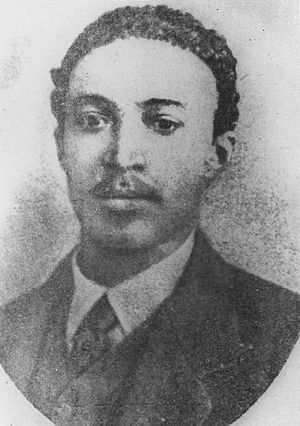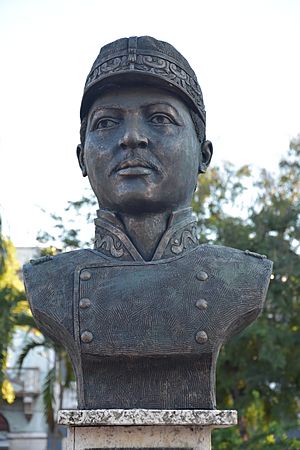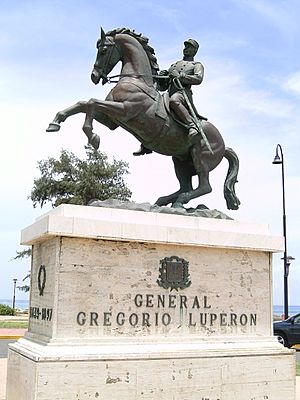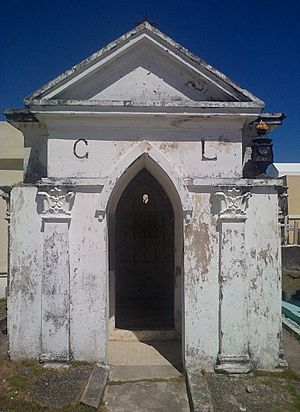Gregorio Luperón facts for kids
Quick facts for kids
Gregorio Luperón
|
|
|---|---|
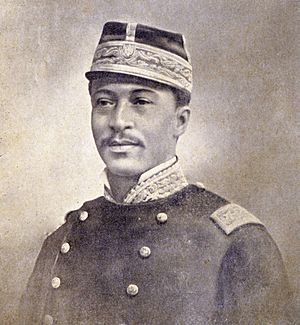 |
|
| 20th President of the Dominican Republic | |
| In office October 7, 1879 – 1 September 1880 |
|
| Preceded by | Cesáreo Guillermo |
| Succeeded by | Fernando Arturo de Meriño |
| Vice President of the Dominican Republic | |
| In office 24 January 1865 – 24 March 1865 |
|
| President | Benigno Filomeno de Rojas |
| Preceded by | Ulises Francisco Espaillat |
| Succeeded by | Benigno Filomeno de Rojas |
| Personal details | |
| Born | September 8, 1839 Puerto Plata, Dominican Republic |
| Died | May 21, 1897 (aged 57) Puerto Plata, Dominican Republic |
| Nationality | Dominican |
| Political party | Blue Party |
| Spouse | Ana Luisa Tavárez |
| Children | Luisa, Jacobo Leoncio, and Elena Maria Tavarez Bernal |
| Parents | Nicolasa Luperón and Pedro Castellanos |
| Profession | Military General |
| Military service | |
| Allegiance | |
| Rank | General |
| Battles/wars | Dominican Restoration War Six Years' War |
Gregorio Luperón (born September 8, 1839 – died May 21, 1897) was an important leader in the Dominican Republic. He was a president, a military general, and a smart politician. He played a key role in getting the Dominican Republic back from Spanish rule in 1863. This event is known as the Restoration of the Dominican Republic.
Luperón was part of a group called the Triunvirato in 1866. He became the President of the local government in Puerto Plata. Later, after a change in government, he became the 28th President of the Dominican Republic in 1879. During his time as president, he worked to make the government separate from religious control, with help from others like Eugenio María de Hostos.
Contents
Early Life and Education
Gregorio Luperón was born on September 8, 1839, in Puerto Plata. His father was Pedro Castellanos and his mother was Nicolasa du Perron. Her last name later changed to "Luperón" to sound more Spanish.
His parents owned a small market stall where they sold homemade foods. Gregorio and his brothers and sisters helped sell these items on the street to support their family.
When he was about 14, Gregorio started working for Pedro Eduardo Dubocq, a French timber businessman. Gregorio was very hardworking and good at his job. Because of this, Mr. Dubocq promoted him to a management position. Mr. Dubocq also let Gregorio read books from his personal library, which helped Gregorio learn a lot.
Fighting for Freedom
In 1861, Spain took control of the Dominican Republic. Gregorio was only 22, but he felt a strong sense of national pride. He was arrested once but managed to escape to the United States. Soon after, he returned to the Dominican Republic to join an uprising in Sabaneta de Yásica in 1863. However, the Spanish quickly stopped this uprising.
After this failure, Gregorio and his friends hid in the mountains. They planned a bigger revolution against the Spanish forces.
The Restoration War Begins
On August 16, 1863, the "Grito de Capotillo" (Call of Capotillo) happened. This was a successful raid near Dajabon led by Santiago Rodriguez. After this, it was Luperón's turn to lead in the provinces of Moca and La Vega. Here, he earned the rank of General.
He soon joined the main operations in Santiago. He was put in charge by General Gaspar Polanco, a leader in the war. Luperón fought the Spanish in the Battle of Santiago on September 6, 1863.
Luperón was a brave and smart leader. He knew a lot about military tactics. He attacked the Spanish Army in Santo Domingo in a battle known as Marques de las Carreras. Even though the Spanish had more soldiers and better weapons, Luperón's forces used guerrilla tactics to defeat them.
He then helped push the enemy out of the provinces of Bani and San Cristobal. He supported Gaspar Polanco's government, believing it would help the war effort regain its strength.
Battle of Bermejo Creek
On September 30, 1863, a key battle happened at Bermejo de Don Juan River. General Santana, a Spanish leader, tried to reach a strategic spot that would have meant defeat for Luperón. But Luperón's forces blocked their path.
After this, the two armies fought on land. General Santana was defeated, and Luperón's forces took control of San Pedro. This victory was very important for the revolution.
After the War
Once the Spanish Army was defeated, Luperón became the Vice President under Benigno Filomeno de Rojas. After the Dominican Republic was fully restored, he went back to his hometown of Puerto Plata and opened a shop.
He did not want Buenaventura Baez to return to power. Because of this, Baez sent Luperón out of the country. A few months later, Luperón returned as part of the Triunvirato group in 1866. This group eventually removed Baez from power and formed a new government.
Another Time in Exile
Buenaventura Baez later took power again, which forced Luperón to leave the country once more. Luperón tried to start a revolution using a steamboat called "El Telegrafo," but it failed. This was partly because the United States was trying to buy the Samaná Peninsula at the time.
Luperón still wanted to return home and gained support from other Latin American countries. When Baez was removed from power in 1873, Luperón was finally able to return safely to Puerto Plata.
President and Minister
When Ulises Espaillat became president, Luperón was named the Minister of War and Marines. But when Espaillat was removed, Luperón had to leave again. He waited almost two years for his enemies to lose power before returning quietly.
In 1879, Luperón was honored in France. He was named Honorary President of some societies in Paris and received the Legion de Honor award.
After a change in government, Luperón became the President of the Provincial Government of Puerto Plata. His twelve months in charge were peaceful and progressive. He held a fair election in 1880, where Fernando Arturo de Merino was elected President. Luperón supported him.
In this new government, Luperón was sent to Europe as a special representative. When he returned, he became a governing delegate for the Cibao region.
The Revolution of 1886
In 1886, a new revolution began. Luperón fought in Puerto Plata and helped Ulises Heureaux win and become president in 1887.
However, Heureaux, who had been a brave fighter like Luperón, started to rule like a dictator. This made Luperón very disappointed. He went abroad to try and organize a campaign against Heureaux, but it did not succeed.
Final Years and Death
Around 1895, General Luperón started having severe tooth pain. After a tooth was removed, the area did not heal, causing an infection. His feet also began to swell, possibly from sitting for months while writing his autobiography. He was being treated by doctors in Saint Thomas.
In 1896, a doctor told Luperón that he was very ill. Luperón said that if he was going to die soon, he wanted his body to be sent back to Puerto Plata. He hadn't thought about returning to the Dominican Republic while Ulises Heureaux was still president.
In December 1896, Heureaux visited Luperón in Saint Thomas as a sign of respect for his past service. Heureaux offered to take Luperón back to Puerto Plata. Luperón accepted but chose to travel on a different boat.
On December 15, 1896, Luperón arrived in Puerto Plata very ill. President Heureaux visited him and arranged for a foreign doctor to care for him. Luperón was bedridden for his last five months. Before he passed away on May 20, 1897, at 9:30 p.m., he tried to lift his head and said, "Men like me, should not die laying down." He died in his beloved hometown of Puerto Plata.
Legacy
The town of Luperón, the Gregorio Luperón International Airport in Puerto Plata, a metro station in Santo Domingo, and the Gregorio Luperón High School for Math & Science in New York are all named after him.
His old home was turned into the Casa Museo General Gregorio Luperón museum. It shows his life through different exhibits.
See also
 In Spanish: Gregorio Luperón para niños
In Spanish: Gregorio Luperón para niños


